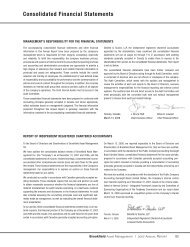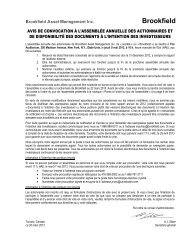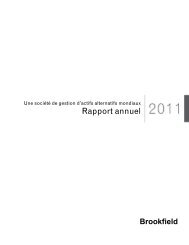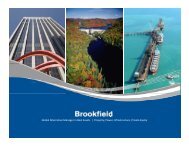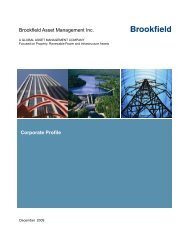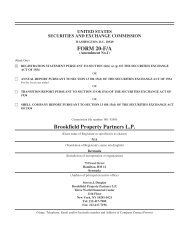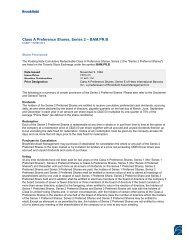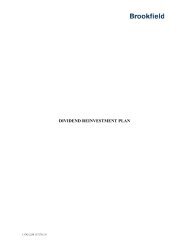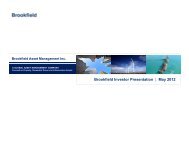Consolidated Financial Statements and Notes - Brookfield Asset ...
Consolidated Financial Statements and Notes - Brookfield Asset ...
Consolidated Financial Statements and Notes - Brookfield Asset ...
Create successful ePaper yourself
Turn your PDF publications into a flip-book with our unique Google optimized e-Paper software.
(i) Equity accounted incomeUnder U.S. GAAP, the company’s equity accounted income has been adjusted for differences in the accounting treatment by theunderlying company as follows:Accounting Treatment Canadian GAAP U.S. GAAPStart-up costs Defer <strong>and</strong> amortize Expense as incurredPension accounting Valuation allowance No valuation allowance /additional minimum liabilityDerivative instruments <strong>and</strong> hedging See Note 1 <strong>and</strong> Note 15 See Note 24(a)(v)Canadian GAAP requires recognition of a pension valuation allowance for an excess of the prepaid benefi t expense over theexpected future benefi t. Changes in the pension valuation allowance are recognized in the consolidated statement of income. U.S.GAAP does not specifi cally address pension valuation allowances. In 2002, U.S. regulators determined that such allowances wouldnot be permitted under U.S. GAAP. In light of these developments, Falconbridge, Norbord <strong>and</strong> Fraser Papers eliminate the effects ofrecognizing pension valuation allowances.(ii) Deferred income taxesThe change in deferred income taxes includes the tax effect of the income statement adjustments under U.S. GAAP. Also, underCanadian GAAP the tax rates applied to temporary differences <strong>and</strong> losses carried forward are those which are substantivelyenacted. Under U.S. GAAP, tax rates are applied to temporary differences <strong>and</strong> losses carried forward only when they are enacted.In 2005 <strong>and</strong> 2004, there were no differences between the substantively enacted rates used under Canadian GAAP <strong>and</strong> the enactedrates used under U.S. GAAP.(iii) Convertible note distributionsUnder Canadian GAAP, the company’s subordinated convertible notes are treated as equity with interest paid thereon recorded asa distribution from retained earnings. This results from the company’s ability to repay these notes <strong>and</strong> meet interest obligations bydelivering its common shares to the holders. Under U.S. GAAP, the subordinated convertible notes would be recorded as indebtednesswith the corresponding interest paid recorded as a charge to income. There is no effect on basic or diluted net income per share.The company redeemed all of its remaining subordinated convertible note obligations during 2005.(iv) Conversion of convertible notesUnder Canadian GAAP, the company’s subordinated convertible notes are treated as equity <strong>and</strong> converted into the company’sfunctional currency at historic rates. Under U.S. GAAP, the subordinated convertible notes are recorded as indebtedness <strong>and</strong>converted into the company’s functional currency at current rates with the corresponding foreign exchange recorded as a chargeto income.(v) Market value adjustmentsUnder Canadian GAAP, the company generally records short-term investments at the lower of cost <strong>and</strong> net realizable value, withany unrealized losses in value included in the determination of net income. However, the company has identifi ed certain distinctportfolios of securities which it has designated to be carried at fair value under Canadian GAAP. Under U.S. GAAP, all tradingsecurities are carried at market, with unrealized gains losses included in the determination of net income.Under Canadian GAAP, derivatives that qualify for hedge accounting are generally off balance sheet. Under U.S. GAAP,all derivative fi nancial instruments are recognized in the fi nancial statements <strong>and</strong> measured at fair value. Changes inthe fair value of derivative fi nancial instruments are recognized periodically in either income or shareholders’ equity (asa component of other comprehensive income), depending on whether the derivative is being used to hedge fair value or cash fl ows.For derivatives designated as cash fl ow hedges, the effective portions of the changes in fair value of the derivative are reported inother comprehensive income <strong>and</strong> are subsequently reclassifi ed into net income when the hedged item affects net income. Changesin the fair value of derivative fi nancial instruments that are not designated in a hedging relationship, as well as the portions ofhedges that are ineffective, are recognized in income.<strong>Brookfield</strong> <strong>Asset</strong> Management | 2005 Annual Report 89



